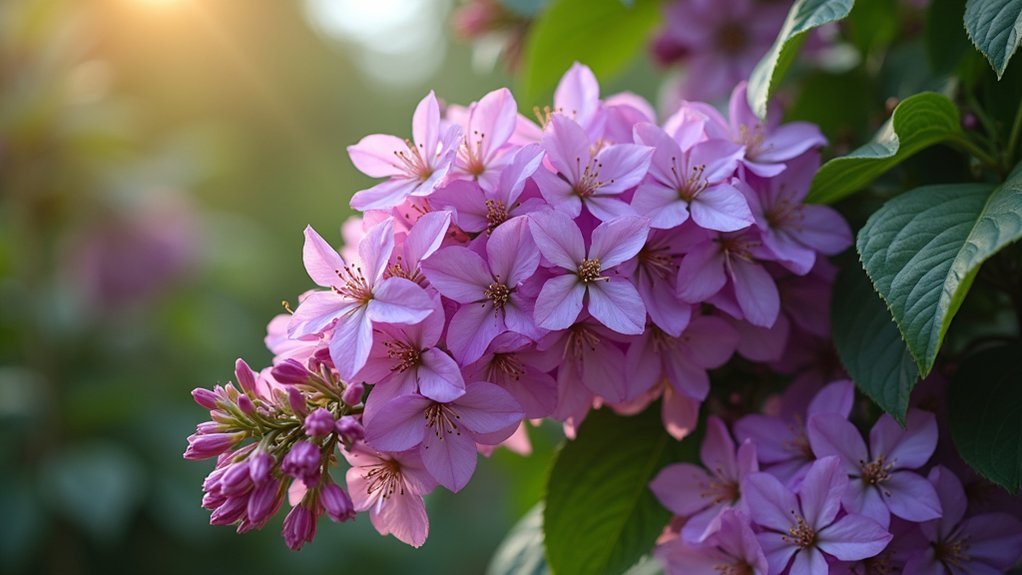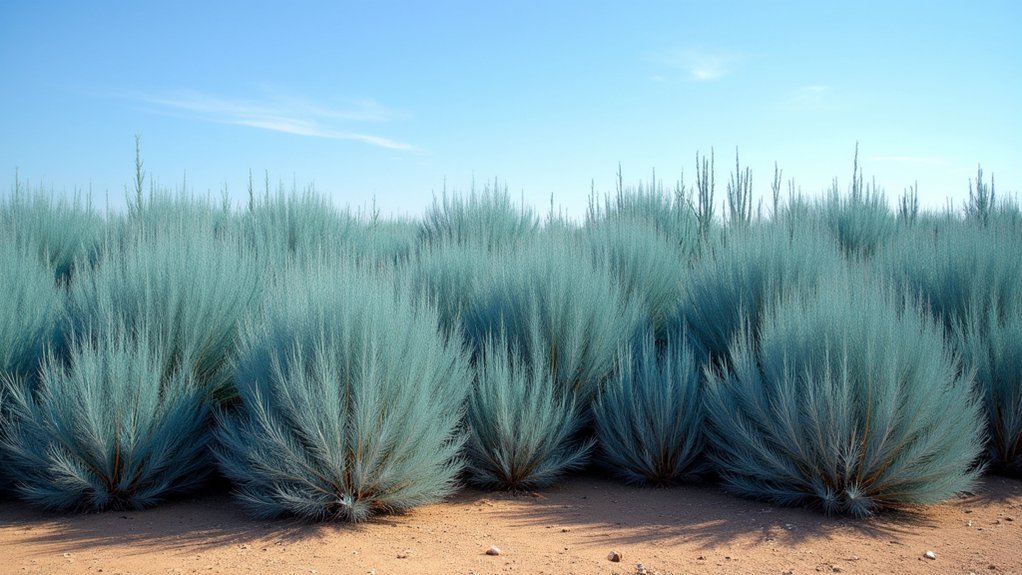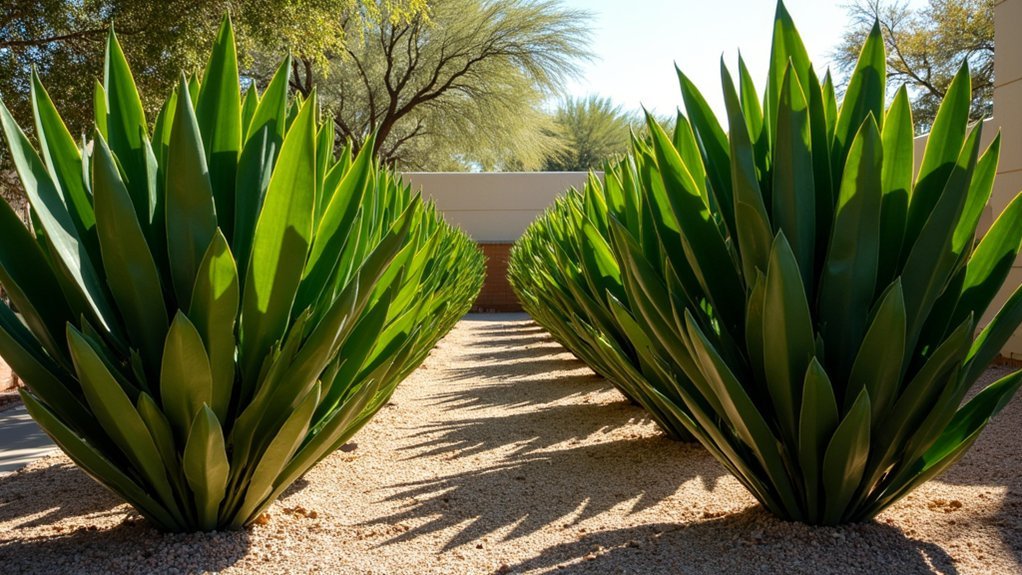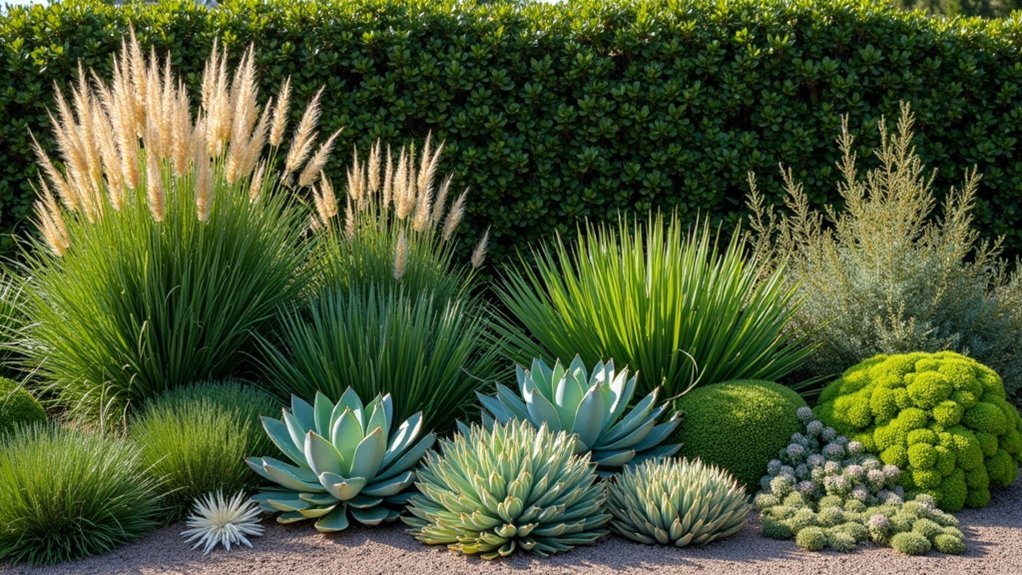Looking for privacy without excessive watering? Consider these drought-tough champions: Muskogee Crape Myrtle for vibrant blooms, English Laurel for dense evergreen screening, Slim Bottlebrush for tight spaces, Carolina Sapphire Cypress for blue-green barriers, Teddy Bear Magnolia for compact elegance, and Sunshine Ligustrum for year-round color. You can also create a mixed screen using these plants for varied textures and heights. Discover how these resilient options can transform your landscape while keeping water bills low.
Muskogee Crape Myrtle: Vibrant Blooms With Minimal Water

When choosing a privacy plant that stands up to drought conditions, the Muskogee Crape Myrtle emerges as an exceptional candidate. This versatile beauty grows 20-30 feet tall with a 15-20 foot spread, creating an effective natural screen with its dense branching from base to crown.
You’ll appreciate its remarkable drought tolerance once established, needing only occasional deep watering during extended dry periods. For the first three months, water twice weekly, then let nature take over.
The lavender-purple blooms last an impressive 120 days, offering both privacy and visual appeal. Planted strategically in groups of 3 or 5 plants, these crape myrtles create a stunning visual impact in your landscape.
Perfect for zones 7-10, it thrives in most soils and requires minimal maintenance. Simply apply a balanced fertilizer in spring and perform light pruning after flowering to maintain its attractive architectural form.
English Laurel: The Resilient Privacy Workhorse
English Laurel thrives in nearly any soil type, from clay to sand, making it a versatile choice for challenging landscapes.
You’ll appreciate its dense, evergreen foliage that quickly creates a natural privacy wall while requiring minimal pruning.
Once established, its extensive root system allows English Laurel to withstand extended dry periods, needing only occasional deep watering during extreme drought conditions. Its large, glossy leaves recover easily from pruning, maintaining the hedge’s attractive appearance even after maintenance.
Versatile Soil Tolerance
Though many privacy hedges demand specific soil conditions, English Laurel stands out for its exceptional adaptability to diverse soil types. You’ll find it thriving in poor, dry, and alkaline soils where other hedges struggle. This versatility extends to coastal areas, where it handles saline soils and urban pollution with remarkable resilience.
What makes English Laurel particularly valuable is its performance across USDA zones 6-9, with some cultivars even tolerating zone 5 conditions. The plant features glossy dark green leaves that maintain their vibrant appearance despite challenging soil environments. Once established, it develops a robust root system that adapts to various soil moisture levels and pH ranges. You won’t need special soil amendments or extensive preparation before planting.
This adaptability, combined with its drought tolerance and resistance to heavy pruning, makes English Laurel an ideal low-maintenance choice for creating privacy screens in challenging soil environments.
Dense Growth Pattern
A standout feature of English Laurel is its remarkably dense growth pattern that creates an impenetrable privacy screen.
You’ll appreciate the broad, leathery leaves (3-7 inches long) that grow tightly packed, minimizing gaps and blocking visibility from all angles. With impressive growth rates of up to 2 feet annually, you can establish effective screening within just a few years.
This evergreen workhorse maintains its privacy function year-round, unlike deciduous alternatives that leave you exposed during winter months. The plant thrives even in heavy shade and still produces its fragrant spring flowers.
- Achieves heights of 15-30 feet with widths of 6-15 feet, creating substantial screening
- Forms both a visual barrier and physical deterrent with its thick foliage structure
- Responds excellently to pruning, which stimulates lateral branching for even denser coverage
Minimal Water Requirements
While English Laurel’s dense foliage provides exceptional privacy, its water efficiency makes it truly remarkable for practical landscaping.
You’ll need to provide consistent moisture during the establishment phase with deep watering every 10-14 days, but patience pays off.
Once established, this resilient shrub develops impressive drought tolerance, requiring minimal intervention even during dry spells.
When you do water, focus on deep, infrequent sessions that encourage robust root development rather than shallow daily sprinkles. This approach prevents fungal issues while building drought resistance.
For best results, make certain well-drained soil enriched with organic matter before planting. The ideal soil pH range is between 4.5 to 7.5, which accommodates most garden soils perfectly.
During extended drought periods, watch for wilting leaves or dropping stem tips—your signal to provide supplemental water.
With proper care, you’ll enjoy a water-efficient privacy screen for years to come.
Slim Bottlebrush: Space-Saving Drought Master
Space constraints needn’t limit your privacy options when you choose Slim Bottlebrush (*Callistemon viminalis ‘CV01’*).
This dwarf variety grows tall but narrow—reaching 9-10 feet in height while spreading just 4-5 feet wide—making it perfect for tight spaces where you need vertical screening without horizontal sprawl. Its native origins in Queensland, Australia make it naturally adapted to challenging conditions.
- Water-wise champion: Extremely drought tolerant once established, requiring minimal irrigation even during dry periods
- Four-season performer: Frost hardy down to -6°C with vibrant bottlebrush flowers in spring and summer that attract birds and pollinators
- Low-maintenance solution: Needs pruning just 1-3 times annually, thrives in most soil types, and resists common diseases
Plant 1-1.5 specimens per linear meter for an efficient, water-conscious privacy screen that works beautifully in any Australian climate.
Carolina Sapphire Cypress: Year-Round Blue-Green Barrier

If you’re searching for a stunning privacy solution, Carolina Sapphire Cypress offers striking blue-green foliage that deer won’t touch.
This fast-growing evergreen creates a dense screen in record time, reaching 25-30 feet tall while maintaining a narrow 10-15 foot spread. With rapid annual growth of 3-5 feet, you’ll achieve privacy faster than with traditional options.
You’ll appreciate its drought tolerance once established, making it an ideal low-maintenance barrier that provides year-round privacy with its distinctive aqua-toned needles.
Striking Blue-Green Foliage
Carolina Sapphire Cypress stands out among privacy plants with its breathtaking silver-blue foliage that maintains its striking color year-round.
This Clemson University cultivar offers more than just visual appeal—its aromatic qualities add another sensory dimension to your landscape.
You’ll appreciate how this evergreen’s distinctive coloration creates a dramatic backdrop for other garden plants while serving as a stunning standalone specimen.
The silver-blue needles provide consistent beauty without seasonal changes, making your privacy screen visually appealing in all seasons. Growing to 20 to 30 feet tall, this cypress creates an effective natural barrier while maintaining an attractive appearance.
- Fast-growing at 3-5 feet annually, quickly establishing your desired privacy barrier
- Requires minimal maintenance to preserve its naturally pyramidal shape
- Thrives in full sun and adapts to various soil conditions, perfect for challenging landscapes
Deer-Resistant Privacy Solution
Homeowners plagued by deer damage will find Carolina Sapphire Cypress an ideal solution for creating privacy without the frustration of browsed foliage. This evergreen naturally deters deer while offering a stunning blue-green barrier that stands 20-30 feet tall at maturity.
For effective screening, plant these cypresses 7-8 feet apart. They’ll thrive in various soil types—from sandy to clay—with minimal maintenance required. The tree’s fast growth rate of 2-3 feet annually means you’ll achieve privacy quicker than with many other screening options.
Unlike boxwoods that need more water, Carolina Sapphire’s exceptional drought tolerance means it needs less than a foot of water annually once established.
You’ll appreciate how this cypress outperforms competitors by combining deer resistance with fast growth rate, minimal pruning needs, and natural pest resistance.
It’s a sustainable choice that provides year-round privacy while eliminating the need for chemical deer repellents.
Fast-Growing Dense Screen
When privacy is your primary concern, Carolina Sapphire Cypress offers unmatched screening capabilities with its rapid growth rate of 3-4 feet annually.
This striking evergreen reaches heights up to 40 feet with a spread of 10-14 feet, creating a dense year-round barrier with minimal maintenance. Plant trees 6 to 8 feet apart for optimal density that creates an effective privacy screen while allowing healthy root development.
Developed at Clemson University in 1968, this Arizona Cypress cultivar thrives in USDA zones 6-9 and adapts to various soil conditions.
You’ll appreciate its resilience once established—particularly in challenging environments.
- Distinctive blue-green foliage provides aesthetic appeal while functioning as an effective windbreak
- Drought and salt tolerant—perfect for coastal properties and arid regions
- Requires virtually no pruning, making it ideal for homeowners seeking low-maintenance solutions
Teddy Bear Magnolia: Compact Elegance for Water-Conscious Gardens

The stately Teddy Bear Magnolia offers three exceptional qualities that make it perfect for privacy-conscious gardeners: compact size, drought tolerance, and year-round visual appeal.
This dwarf southern magnolia maintains a manageable, pyramidal form ideal for small spaces while creating effective visual barriers.
You’ll appreciate how this versatile tree evolves from establishment to low-maintenance living. After two years of regular deep watering, it develops impressive drought resilience while tolerating occasional soggy conditions. The enormous creamy blooms create a stunning visual display that enhances any garden setting.
The glossy dark green leaves with velvety reddish-brown undersides create year-round screening, complemented by fragrant 6-8 inch white blooms from spring through fall.
When planted as a hedge or accent, its dense branching naturally deters unwanted views while attracting pollinators. Deer typically avoid it, making it truly worry-free once established.
Sunshine Ligustrum: Bold Color Without the Thirst
Sunshine Ligustrum stands out as a vibrant powerhouse for privacy-focused gardens where water conservation matters. This striking shrub offers bright lemon-yellow foliage that maintains its cheerful color year-round, creating instant impact in your landscape while requiring minimal water once established.
- Reaches just 4 feet tall with a bullet-shaped spread, perfect for creating manageable privacy screens without overwhelming your space.
- Thrives in various soil types and tolerates pollution, heat, and drought—making it ideal for urban gardens and challenging environments.
- Lives up to 30 years with virtually no maintenance needed—no pruning required and naturally deer and pest resistant.
You’ll appreciate how quickly this hardy plant establishes itself while brightening even the dullest corners of your water-conscious garden. The non-invasive nature of Sunshine Ligustrum makes it an environmentally responsible choice for modern landscape designs.
Creating a Mixed Drought-Tolerant Screen for Maximum Impact

While Sunshine Ligustrum offers striking solitary beauty, combining multiple drought-resistant plants creates a privacy screen with unmatched visual interest and ecological resilience. You’ll achieve greater depth and four-season appeal by layering plants of varying heights, textures, and seasonal characteristics. Consider adding Tuscan Blue Upright Rosemary with its starting price $39.95 for an economical addition to your drought-tolerant screen.
| Plant | Key Features |
|---|---|
| Western Arborvitae “Ember Waves®” | Tall backdrop (25ft), color-changing foliage |
| Viburnum “Popcorn” | Mid-height (8ft), spring flowers, fall color |
| False Cypress | Narrow profile (4ft wide), fern-like texture |
| Callistemon “Little John” | Red bottlebrush flowers, attracts pollinators |
| Upright Rosemary | Aromatic foliage, narrow form for tight spaces |
Space plants according to mature width, amend soil before planting, and apply mulch to retain moisture. Initially establish with regular watering, then gradually reduce as plants develop drought tolerance. Selective pruning maintains density while preserving natural form.
Frequently Asked Questions
How Soon Will These Plants Create Effective Privacy Screens?
You’ll see initial privacy screens forming within 2-5 years. Most fast-growing plants add 1-3 feet annually, creating effective coverage in 5-10 years, especially with proper spacing and regular pruning.
Can These Drought-Tolerant Plants Survive Winter Freezes?
Yes, many drought-tolerant plants can survive freezes. You’ll have best results with evergreen holly, juniper, and boxwood. Protect them with mulch and proper watering before winter to enhance their cold hardiness.
Do These Plants Attract Beneficial Wildlife or Pollinators?
Yes, you’ll find these plants attract a variety of beneficial wildlife. They provide nectar for butterflies and bees, seeds for birds, and shelter for small mammals, enhancing your garden’s biodiversity and ecological health.
How Often Should New Drought-Tolerant Privacy Plants Be Watered?
Water your new drought-tolerant plants daily for the first week, then deeply once weekly for two years. You’ll need to check soil moisture regularly and adjust for high temperatures, gradually reducing frequency as roots establish.
What Soil Amendments Improve Survival Rates in Poor Conditions?
You’ll boost survival rates in poor soil by adding compost and aged manure to improve fertility and water retention. Mulch heavily to conserve moisture, and consider sphagnum moss for sandy soils that drain too quickly.
In Summary
You’ve discovered seven exceptional plants that create privacy without demanding constant watering. Whether you choose the flowering beauty of crape myrtles or the dense foliage of English laurel, these drought-resistant options will transform your outdoor space. Combine several varieties for visual interest and maximum screening effect. With these water-wise choices, you’ll enjoy both privacy and sustainability in your garden for years to come.





Leave a Reply